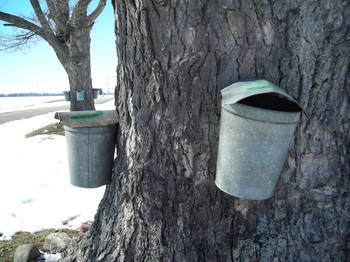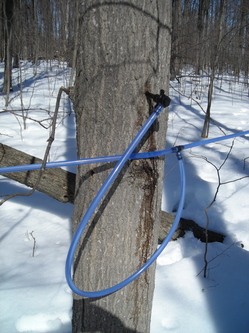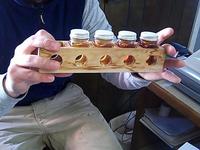A visit to Snow's Sugarbush

Pails have been used to collect maple sap for hundreds of years. These trees show several of the nearly 80,000 pails that Snow's Sugarbush of Mason uses to collect maple syrup this season.
Corinna Borden | Contributor
A sugarbush is a grove of trees dominated by the Sugar maple (Acer saccharum - one guess as to which word means sugar). Sugar maples are so named because they have the highest sugar content and thus are the best to tap to make maple syrup.
As with so many things we eat (artichokes, oysters, truffles) I wonder about the many failed attempts that happened when boiling down tree sap into something palatable. But that is another story.
Tapping trees for syrup was a Native American tradition that soon caught on with the settlers. When the spring days hit 45 to 50 degrees and are 20 degrees at night, there is enough temperature fluctuation for the sap to start "running."

The newest innovation for tapping trees is to use a vacuum to pump the sap out of the tree, saving labor and time.
Corinna Borden | Contributor
According to Uncle Sam, maple syrup has to contain 66.7 percent sugar. The general rule of thumb is that it takes 40 gallons of sap to make one gallon of syrup. There are several ways to reduce the amount of water - mostly depending on the amount of sap you have.
If I were to drill a 2 ½ inch hole into the sugar maple in my back garden, put a tap in it, a pail under the tap, and a cover to keep the rain out, I could probably collect about 10 gallons over the course of the 6 week season. 10 gallons would boil down to about one quart of finished maple syrup.
If, however, I am dealing with two large sugarbushes and nearly 80,000 pails tapped into trees all over the neighborhood, like Snow’s Sugarbush operation, the process would be more complex. The newest innovation adopted by the Snow family is the use of a vacuum generator and lines running from the trees instead of pails. The two sugarbushes behind their barns do not have pails attached to the trees. Rather, it is a cobweb of connecting blue tubes that move the sap under the ground and directly into the evaporator machine via an vacuum.
When sap arrives at the processing area, the first stop it makes is to the evaporating reverse osmosis machine that removes 75 percent of the water. The reduced liquid is then boiled. Here is a video of Matt Snow describing the boiling process.
Once the syrup reaches the 66.6 percent sugar content, it is then graded into different categories. The color variations and mineral content are completely dependent upon the tree, and there is a lot of yearly variation. There are four grades of syrup: light amber, medium amber, dark amber and Grade B. Due to the popularity of the detoxifying diet, The Master Cleanse, Grade B syrup has become much more desired in the last 10 years.

The grading system for maple syrup involves gauging the color of the syrup.
Corinna Borden | Contributor
Corinna runs the Westside Farmers Market and blogs about all things food related (though her book is about something completely different).


Comments
Paul the Malcontent
Tue, Mar 9, 2010 : 9:43 a.m.
http://www.snowssugarbush.com/